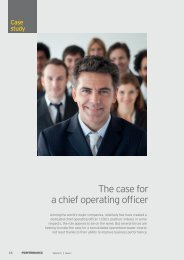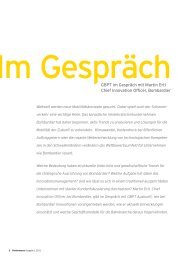PERF RMANCE 04 - The Performance Portal - Ernst & Young
PERF RMANCE 04 - The Performance Portal - Ernst & Young
PERF RMANCE 04 - The Performance Portal - Ernst & Young
Create successful ePaper yourself
Turn your PDF publications into a flip-book with our unique Google optimized e-Paper software.
Supply chain transformation<br />
<strong>The</strong>se initial interventions were very<br />
successful and, in early 2009, SCALE<br />
was established with <strong>Ernst</strong> & <strong>Young</strong> as<br />
a strategic advisor. Since then we acted<br />
as "transformation guides" and "change<br />
coaches", working alongside the supply<br />
chain leadership team and the SCALE<br />
workstream leaders to help them launch<br />
and drive forward the SCALE initiative.<br />
Setting sail from Porto<br />
We started the journey of exploration and<br />
transformation in Porto, Portugal, when<br />
the supply chain EMEALA logistics team<br />
came together for their annual summit.<br />
This was a key moment. An opportunity to<br />
really create momentum and connect with<br />
those people who would be most involved<br />
and affected by the transformation project.<br />
We agreed upfront with the leadership<br />
team that the whole meeting would focus<br />
only on the need for transformation. In this<br />
way, they were involved right from the start<br />
in the plans for the new initiative.<br />
<strong>The</strong> theme for the Porto summit in<br />
November 2008 was “managing change<br />
together.” Working with around 60<br />
members of the global team, we spent<br />
three days building the case for change<br />
Figure 1. Supply Chain Alignment EMEALA<br />
across FME’s supply chain. Dr. Emanuele<br />
Gatti reinforced the importance of supply<br />
chain both in safeguarding cash flow and in<br />
laying the foundations for the company’s<br />
future growth.<br />
<strong>The</strong> Porto summit was key not just<br />
because it provided the opportunity to<br />
engage people in the need for change<br />
within the organization’s global supply<br />
chain operations, it was also the start of<br />
generating a real feeling and need for a<br />
common “community of spirit” across the<br />
different supply chain functions.<br />
One of the first things we did at the<br />
summit was to identify the perceived<br />
strengths and weaknesses in FME’s<br />
supply chain operations. <strong>The</strong>n we<br />
developed expectations for the future. (as<br />
summarized Figure1).<br />
FME before<br />
FME tomorrow<br />
This was a pivotal moment in our<br />
relationship with FME and marked<br />
the beginning of a shared journey of<br />
transformation and organizational change.<br />
During this journey, we used a variety of<br />
techniques to assist FME and some of the<br />
most important ones are highlighted in the<br />
remainder of this article.<br />
• High stock levels<br />
• Low forecast accuracy<br />
• Lack of flexibility<br />
• Missing transparency<br />
• Targets in conflict<br />
• Diverse and unconnected systems<br />
• Transforming the way we work across the supply chain<br />
• Ensuring reliability in our supply chain performance<br />
• Supporting the growth of FME as a leading renal therapy company<br />
Source: Fresenius Medical Care<br />
• Demand driven<br />
• Global process optimization<br />
• Customer focused<br />
• Optimization across company<br />
• Proactive<br />
• Transparency<br />
• Common SAP based platform<br />
51






